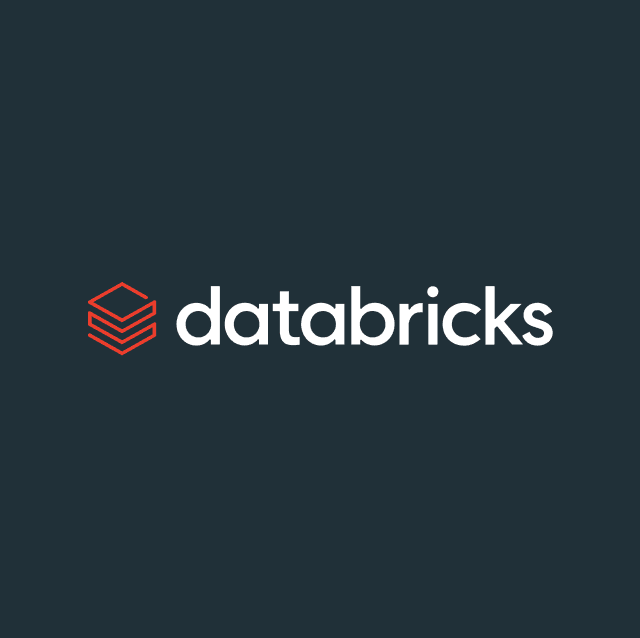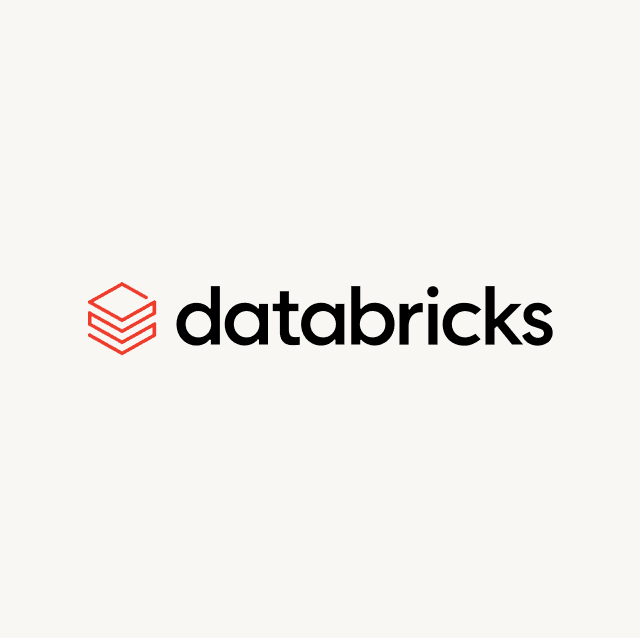As the author of the book on the initial version of Adobe Analytics, I know quite a bit about Adobe’s prowess in digital analytics. Adobe Analytics and Customer Journey Analytics (CJA) are super-advanced digital analytics products that provide a world-class interface (Analysis Workspace). Since Hightouch is a composable solution, customers can use it alongside any digital analytics platform. And since Adobe Analytics is the leader in the enterprise, many Hightouch clients use Adobe Analytics or the newer version called Customer Journey Analytics (CJA).
Enterprises primarily use Adobe Analytics/CJA to perform the following functions:
- Optimize digital properties - Track how users engage with digital properties to identify opportunities for improvement (engagement, conversion, or experience).
- Improve marketing spend - Track the success or failure of digital campaigns to optimize marketing spend.
- Improve customer journeys - Leverage online and offline data to improve customer journey experiences across all devices.
In this post, I’ll share several ways that Hightouch can improve Adobe Analytics/CJA based on conversations I have had with Hightouch customers.
Simplify data collection
To use Adobe Analytics/CJA, you collect or import events and properties on your website or mobile application. These events/properties represent actions taken by users and can include page views, cart additions, form submissions, etc. Most Adobe Analytics customers collect these events and properties via JavaScript tags or SDKs.
While event collection for Adobe Analytics is critical, Adobe tags are often just one of many tags collecting data on digital properties. You might also have tags for advertising pixels and other SaaS products. Sometimes the same data is sent to multiple tags, leading to complexity and slowing down digital properties. In many cases, the data collected is also forwarded to cloud data warehouses.

Some Hightouch clients have used Hightouch Events to collect and distribute events to various SaaS destinations. This data hydration can be done in real-time (event streaming) or in batches via the data warehouse. This “collect once” approach is becoming popular as organizations attempt to simplify their martech stacks and improve performance. Since Hightouch is a vendor-agnostic product used to hydrate hundreds of SaaS products, Hightouch Events can be used as the primary event collector. This approach offers much more data consistency, as the same events are being sent to multiple downstream destinations, so data in different SaaS products should be identical.
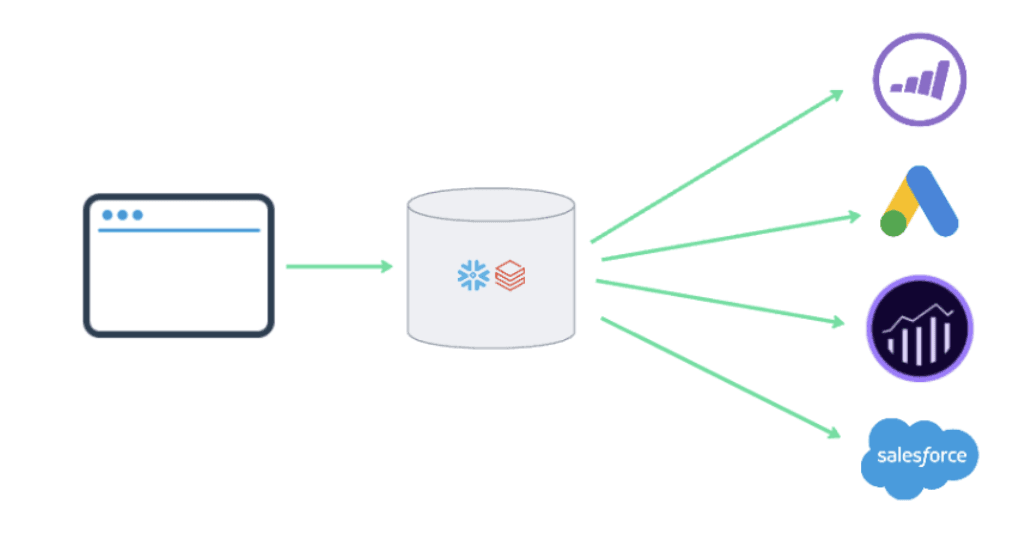
In addition, while most organizations tend to stick with their chosen digital analytics product indefinitely, having vendor-specific tags within your digital products makes it very difficult to switch vendors. For example, switching vendors would require a lot of work if you have Adobe Analytics tags littered throughout your website or mobile app. However, with a generic data collection method (like Hightouch Events), you could change the endpoint to which events are sent if you need to make updates or switch analytics vendors.
Improve Adobe Analytics data through enrichment
All digital analysts want complete and trustworthy data for analysis. However, digital analytics products collect data as users engage with digital products. As such, digital analytics products like Adobe Analytics can only access data during data collection. For example, if a user adds a product to the shopping cart, Adobe Analytics can easily record what product was added, its SKU, its color, etc. However, it is more difficult for Adobe Analytics to document the customer’s current lifetime value at the time of the cart addition or the last product the user purchased. While there are some ways to do this with eVar persistence, it isn’t reliable due to cookie deletion and value overwriting issues. Therefore, Adobe Analytics can miss a lot of the user and event context that would be helpful for digital analysis or segment/audience creation.
To improve this, many organizations enrich user and event data collection by enriching data through the data warehouse. When data is collected, instead of being sent directly to Adobe Analytics, it is sent to the warehouse (often Snowflake, Databricks, BigQuery, Redshift, Azure, etc.).
Once this data hits the warehouse, Hightouch can enrich the data with data from the warehouse. For example, if Adobe Analytics knows the ID of the users, Hightouch can pull data about that user (age, # of kids, income, CLV) and pass those attributes to Adobe Analytics. At the same time, if the user is viewing a product (Product View Event), the product ID/SKU can be passed through the warehouse, where Hightouch can enrich it with cost information, inventory level, etc. This approach to data collection allows Adobe Analytics to get more data about users and events from the warehouse when the event occurs. This approach also means that these data points are “locked in” at that point in time, so they don’t get retroactively changed (as is the case with SAINT Classifications/Lookup metadata). In the example shown below, you would know that the user’s CLV was $1,250 when the product view event occurred, and in the future, it may be different for future events.
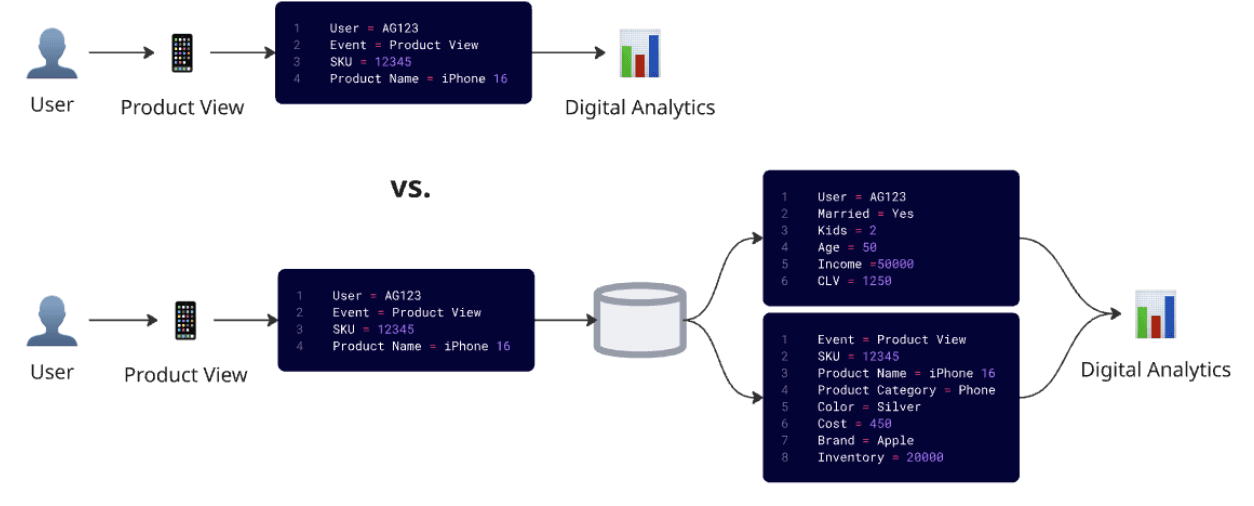
This additional user and event information gives digital analysts more data for analysis. For example, an analyst could look at product conversion rates (Orders/Product Views) by user income or CLV through eVar breakdowns. Better analytics data should lead to more opportunities for improving digital properties. Using Hightouch, more complete data can be sent to Adobe Analytics/CJA, and the data sent is from the data warehouse, which should be the ultimate source of truth.
Moreover, the additional data sent from the warehouse to Adobe Analytics happens server-to-server, so the data passed is not exposed to debugging tools. Therefore, this user and event data are not exposed to end users or competitors.
Improve segments used for analysis or experimentation
Another way Hightouch improves Adobe Analytics/CJA is by helping marketers and digital analysts build better segments (audiences). As seen in the previous section, sending data to Adobe Analytics/CJA via the data warehouse can add more context and attributes to the Adobe Analytics/CJA implementation. These additional data points can be used when building Adobe Analytics segments.
For example, in the scenario outlined above, marketers or digital analysts could build segments where customer lifetime value (CLV) is greater than or less than a specific amount (e.g., $1,000) or narrow advertising audiences based on user income. More comprehensive data about users and events allows Adobe Analytics users to build more granular and complex segments. These granular segments can be used to enhance data analysis, but they can also aid in experimentation. For example, it’s common to build a segment of users and have that segment be sent to Adobe Target for experimentation or personalization. The additional data attributes passed via Hightouch can inform which users should see specific A/B tests or personalized content. And if your organization is using a different experimentation tool (e.g., Optimizely), Hightouch can send user audiences to any experimentation tool, aligning audience membership across all tools.
While adding additional data to Adobe Analytics to help build better segments is great, there are often cases where it may be too costly to import all of the data you need for segments into Adobe. For example, suppose your organization tracks support tickets with Zendesk. Sending all customer support ticket data to Adobe Analytics/CJA could be too expensive. But what if you need to build a segment/audience encompassing Adobe Analytics data in Adobe Analytics and Zendesk customer support data (see a more detailed example here)? Instead of sending all Zendesk customer support data to Adobe Analytics/CJA, you could build the desired segment/audience in Hightouch, which leverages all customer data (including Zendesk) in the warehouse. The segment/audience might look like this:
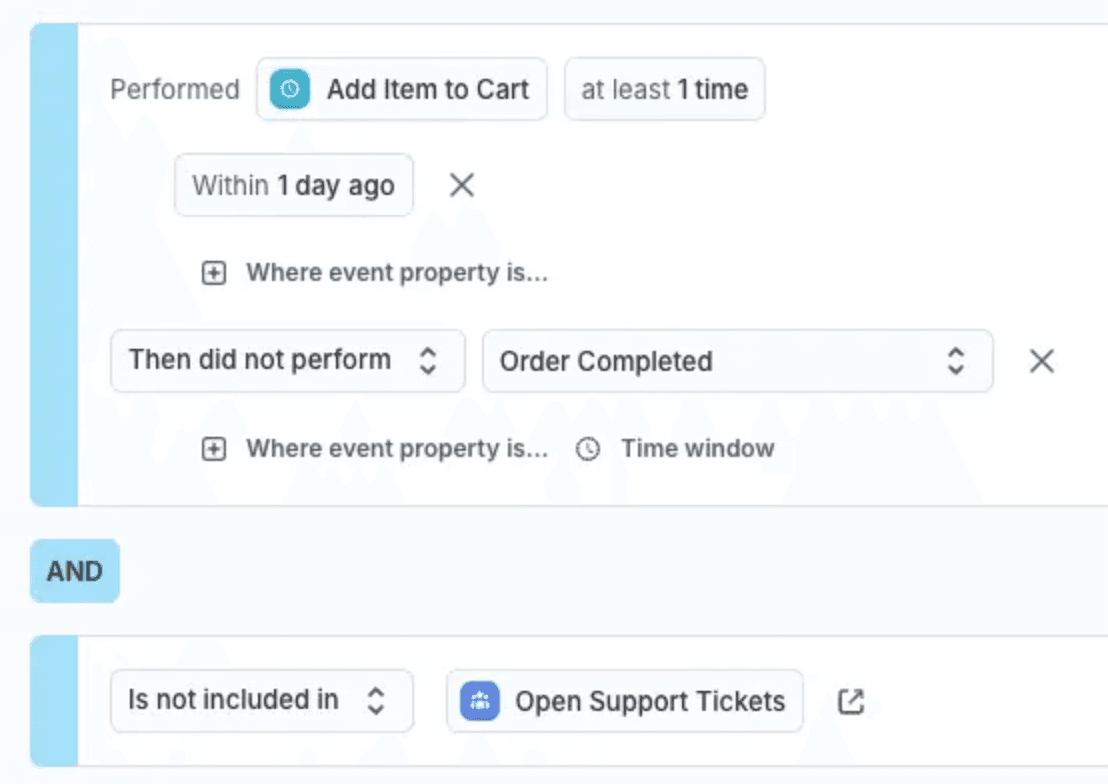
Once this segment/audience is built in Hightouch, the list of Adobe ECIDs can be sent to Adobe Analytics, where it can be acted upon via analysis, experimentation, or personalization. Therefore, you can build the audience you need in Adobe Analytics without duplicating and paying for all your customer data. This saves you time and money!
Trigger analytics events based on data warehouse activity
As mentioned earlier, the bedrock of Adobe Analytics is user actions or events taking place in digital products. These events are often captured via JavaScript or SDKs. However, users can trigger events not occurring on digital properties. For example, imagine a scenario where a user purchases a product on a website, but then returns the product at a physical store. The online purchase may be captured in Adobe Analytics, but the return event must be imported into Adobe Analytics. While this is possible (e.g., Transaction ID in Adobe Analytics or offline Import in CJA), many organizations don’t take the time or have the resources to do this.
However, since the product return data likely exists in your data warehouse, Hightouch can trigger a product return event as soon as it appears. This product return event and all required user and product information can be sent to Adobe Analytics. This event trigger can be set up once and will be on in perpetuity. This event trigger gives marketers and digital analysts more accurate data by subtracting product returns from orders to see net sales. These additional events ensure that business decisions are not made based on inflated order counts without considering product returns.
Of course, this is just one example of how Hightouch-triggered events could improve Adobe Analytics. Another example is importing all advertising impressions, clicks, and costs into Adobe Analytics. Hightouch could also automatically update SAINT Classification/Lookup files, sending the latest metadata from the warehouse to Adobe Analytics/CJA.
Save money on Adobe Analytics contract via curation
While Adobe Analytics is fantastic, it isn’t the cheapest digital analytics product on the market! Over the years, I’ve heard from many organizations that their Adobe Analytics costs can be pretty high. Adobe Analytics pricing is based on how much data is collected, so the more pageviews and events you collect, the more you pay Adobe.
However, not all digital property traffic and events are the same. You may put an Adobe Analytics tag on all website pages, but never look at data in specific sections, such as the careers pages. While it may be tempting to pick and choose where you place Adobe Analytics tags to save money, most organizations don’t do this because it would be too much work.
You can use Hightouch to curate what data is sent to Adobe Analytics instead of sending all data. While all data can be sent to the warehouse for historical purposes, Hightouch’s Reverse ETL feature allows you to pick which events/properties are sent to Adobe Analytics. Determining which events are sent to Adobe Analytics can be based on event type, website section, or any other mechanism. This approach provides complete control over what data is sent to Adobe Analytics, which allows you to control how much Adobe bills you. Based on business needs, this can also be changed at any time, should you want to send more or less data to Adobe at any given time.
Additionally, one of the common challenges in Adobe Analytics is “bot” traffic. “Bot” traffic is traffic to digital properties sent by scripts, AI, or other non-human sources. This “bot” traffic can skew data, alter conversion rates, and cost your organization more money. But if you pass data to Adobe Analytics via Hightouch, you can build rules to identify “bot” traffic and prevent data from going to Adobe Analytics. Eliminating “bot” traffic creates a more accurate, cleaner data set for analysis.
De-duplicate users and unique visitors through identity resolution
One of the biggest challenges in Adobe Analytics is de-duplicating users. Since a lot of user traffic is anonymous, it can be challenging to stitch anonymous and known users together, especially if the user authenticates long after their anonymous traffic has occurred. While Adobe Analytics does what it can using the ECID, it often only has visibility into a subset of user data - data that occurs on the website and mobile application.
Conversely, most organizations have all customer data in their data warehouse. In the warehouse, the Adobe ECID may be one of many customer IDs associated with the user. Therefore, many organizations leverage Hightouch’s warehouse-based identity resolution feature to de-duplicate users across multiple identifiers. These identifiers can include names, emails, phone numbers, etc., and can be performed deterministically or probabilistically. Hightouch can pass a more accurate user ID to Adobe Analytics in addition to or in place of the Adobe ECID. A more precise user ID in Adobe Analytics gives you more accurate unique visitor counts (helps with conversion rates), better marketing attribution, and improved user segments.
Final thoughts
Adobe Analytics is a powerful marketing tool used by thousands of enterprises. For decades, many organizations have had Adobe Analytics tags on their websites and mobile applications. However, as organizations modernize their tech stacks, new tools like Hightouch are being used to help deliver more and better-quality data to marketers and data teams.
The concepts above explain how some leading Adobe customers combine Hightouch and Adobe Analytics to streamline data collection, improve data quality, expand analysis opportunities, and save money. At Hightouch, we believe there are countless ways to leverage warehouse data to improve downstream SaaS applications, and Adobe Analytics is no exception.
To learn more about how Hightouch can help you get the most out of your Adobe products, grab some time with our solutions team.
This blog is part of a series about getting more from your Adobe products by using Hightouch. To learn more, you can also read:










